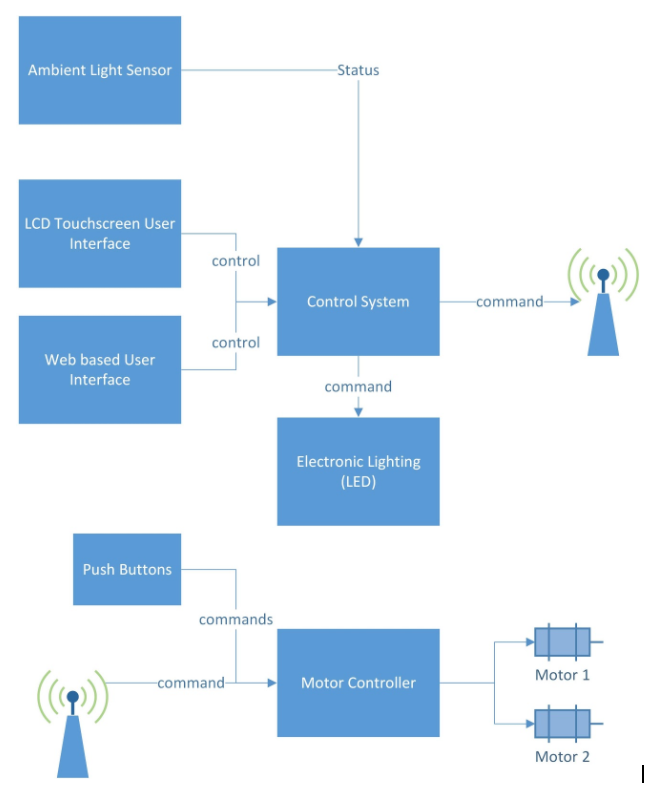Motivation
Home automation is becoming increasingly popular, but the barrier to entry remains quite high. Most complete systems involve intricate installation and custom wiring which makes them expensive and difficult to install in existing homes. Automation, however, offers many benefits: energy efficiency, convenience, and security. Take lighting, for instance. People often fail to effectively use natural light due to the inconvenience of manually adjusting shades. It is much easier to simply flip the light switch. Furthermore, once the sun sets, or goes behind a cloud, lights again might be necessary, requiring more manual adjustment.
Our system solves this problem by simultaneously controlling lights and shades in a room. No existing system that we are aware of for retrofitting shades is also capable of controlling lights. We therefore designed a low-cost (less than $100) system that can be retrofitted to existing shades and lights with no additional wiring. The system is capable of offering both manual control through a touchscreen interface, as well as automated control. The user will be able to set a target brightness level, and the system will automatically adjust lights and shades to reach and maintain this target as the ambient lighting conditions vary. This is the primary novel feature that we offer as opposed to existing systems, particularly the integrated light and shade automation. The system will also expose a web interface to allow for configuration and control from a smartphone or some other web-connected device.
Logical Structure

Fig. 1: High Level System Block Diagram
Since there are two primary things we are controlling (lights and shades), and these things are generally installed in different places in a typical home, we opted to divide our system into two primary modules: the shade controller and the light controller. This organization is shown in Fig. 1. These two controllers communicate over the user’s home WiFi network. This way, the system can also be accessed and controlled from any networked device in the home. The light controller also acts as a central controller for the overall system, monitoring the ambient light level and sending commands to the shade controller.
The light controller in the prototype is mounted on a breadboard, but in a final production version would be designed to replace a conventional light switch and be mounted inside of the wall. This controller also has most of the user interface on its touchscreen, since light switches are generally in much more convenient locations than shades. The shade controller consists of several modules: the control unit and two drive units. The drive units are therefore modular and separate, so they can be mounted in a custom fashion to best adapt to the way that the user has their shades installed.
Relevant Standards
The primary standard utilized in our design in IEEE 802.11 (WiFi). The details of meeting the 802.11 specification, however, are abstracted away by our use of the ESP8266 WiFi controller. This controller handles the low level 802.11 interfacing, as well as implementing the TCP/IP stack so we did not need to worry directly about these features.
Existing Intellectual Property
Patent US7417397B2: Automated shade control method and system
This patent covers an automatic shade system which adapts to various lighting conditions. We do not, however, have a radiometer in our design, our system is designed for retrofit and does not itself include a window covering, and additionally controls lights.
Patent US20110164304A1: Weather-responsive shade control system
This patent details a complex control algorithm for shades to optimize factors such as room heating, illumination level, and occupancy level. Our system is much simpler, handling only ambient brightness level, and is not covered by this patent.
Patent US6084231A: Closed-loop, daylight-sensing, automatic window-covering system insensitive to radiant spectrum produced by gaseous-discharge lamps
This system takes into account ambient room lighting, but for a different reason. Instead of controlling interior lights, it is designed to be able to sense the amount of ambient daylight admitted through the window and adapt accordingly, ignoring the contribution of light from artificial florescent bulbs.
